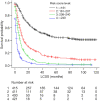A nomogram prognostic model for large cell lung cancer: analysis from the Surveillance, Epidemiology and End Results Database
- PMID: 33718009
- PMCID: PMC7947411
- DOI: 10.21037/tlcr-19-517b
A nomogram prognostic model for large cell lung cancer: analysis from the Surveillance, Epidemiology and End Results Database
Abstract
Background: Currently, there is no reliable method for predicting the prognosis of patients with large cell lung cancer (LCLC). The aim of this study was to develop and validate a nomogram model for accurately predicting the prognosis of patients with LCLC.
Methods: LCLC patients, diagnosed from 2007 to 2009, were identified from the Surveillance, Epidemiology and End Results (SEER) database and used as the training dataset. Significant clinicopathologic variables (P<0.05) in a multivariate Cox regression were selected to build the nomogram. The performance of the nomogram model was evaluated by the concordance index (C-index), the area under the curve (AUC), and internal calibration. LCLC patients diagnosed from 2010 to 2016 in the SEER database were selected as a testing dataset for external validation. The nomogram model was also compared with the currently used American Joint Committee on Cancer (AJCC) tumor-node-metastasis (TNM) staging system (8th edition) by using C-index and a decision curve analysis.
Results: Eight variables-age, sex, race, marital status, T stage, N stage, M stage, and treatment strategy-were statistically significant in the multivariate Cox model and were selected to develop the nomogram model. This model exhibited excellent predictive performance. The C-index and AUC value were 0.761 [95% confidence interval (CI), 0.754 to 0.768] and 0.886 for the training dataset and 0.773 (95% CI, 0.765 to 0.781) and 0.876 for the testing dataset, respectively. This model also predicted three-year and five-year lung cancer-specific survival (LCSS) in both datasets with good fidelity. This nomogram model performs significantly better than the 8th edition AJCC TNM staging system, with a higher C-index (P<0.001) and better net benefits in predicting LCSS in LCLC patients.
Conclusions: We developed and validated a prognostic nomogram model for predicting 3- and 5-year LCSS in LCLC patients with good discrimination and calibration abilities. The nomogram may be useful in assisting clinicians to make individualized decisions for appropriate treatment in LCLC.
Keywords: Large cell lung cancer (LCLC); nomogram; prognosis; prognostic model.
2021 Translational Lung Cancer Research. All rights reserved.
Conflict of interest statement
Conflicts of Interest: All authors have completed the ICMJE uniform disclosure form (available at http://dx.doi.org/10.21037/tlcr-19-517b). The authors have no conflicts of interest to declare.
Figures







Similar articles
-
Clinicopathological characteristics and prediction of cancer-specific survival in large cell lung cancer: a population-based study.J Thorac Dis. 2020 May;12(5):2261-2269. doi: 10.21037/jtd.2020.04.24. J Thorac Dis. 2020. PMID: 32642131 Free PMC article.
-
Development and validation of a novel nomogram to predict the overall survival of patients with large cell lung cancer: A surveillance, epidemiology, and end results population-based study.Heliyon. 2023 May 6;9(5):e15924. doi: 10.1016/j.heliyon.2023.e15924. eCollection 2023 May. Heliyon. 2023. PMID: 37223713 Free PMC article.
-
Development and validation of nomogram prognostic model for early-stage T1-2N0M0 small cell lung cancer: A population-based analysis.Front Oncol. 2022 Nov 17;12:921365. doi: 10.3389/fonc.2022.921365. eCollection 2022. Front Oncol. 2022. PMID: 36465408 Free PMC article.
-
Gender-specific nomogram models to predict the prognosis of male and female lung adenocarcinoma patients: a population-based analysis.Ann Transl Med. 2021 Nov;9(22):1654. doi: 10.21037/atm-21-5367. Ann Transl Med. 2021. PMID: 34988163 Free PMC article.
-
A prognostic nomogram for pancreatic ductal adenocarcinoma patients' all-cause survival in a Surveillance, Epidemiology, and End Results analysis.Transl Cancer Res. 2020 May;9(5):3586-3599. doi: 10.21037/tcr-19-2962. Transl Cancer Res. 2020. PMID: 35117722 Free PMC article.
Cited by
-
Development and Validation of a Prognostic Model to Predict Overall Survival for Lung Adenocarcinoma: A Population-Based Study From the SEER Database and the Chinese Multicenter Lung Cancer Database.Technol Cancer Res Treat. 2022 Jan-Dec;21:15330338221133222. doi: 10.1177/15330338221133222. Technol Cancer Res Treat. 2022. PMID: 36412085 Free PMC article. Clinical Trial.
-
Construction and validation of a nomogram model to predict the overall survival rate of esophageal cancer patients receiving neoadjuvant chemotherapy: A population-based study.Front Surg. 2023 Jan 6;9:1066092. doi: 10.3389/fsurg.2022.1066092. eCollection 2022. Front Surg. 2023. PMID: 36743892 Free PMC article.
-
Incidence and prognostic nomogram for resected non-small cell neuroendocrine tumor: A population-based respective study in China and the SEER database.Heliyon. 2023 Apr 8;9(4):e15319. doi: 10.1016/j.heliyon.2023.e15319. eCollection 2023 Apr. Heliyon. 2023. PMID: 37089398 Free PMC article.
-
Whole-exome and targeted gene sequencing of large-cell lung carcinoma reveals recurrent mutations in the PI3K pathway.Br J Cancer. 2023 Aug;129(2):366-373. doi: 10.1038/s41416-023-02301-2. Epub 2023 May 13. Br J Cancer. 2023. PMID: 37179440 Free PMC article.
-
Development of a nomogram for overall survival prediction in primary upper lobe lung cancer patients: A SEER population-based analysis.PLoS One. 2025 Apr 29;20(4):e0321955. doi: 10.1371/journal.pone.0321955. eCollection 2025. PLoS One. 2025. PMID: 40299864 Free PMC article.
References
-
- Howlader N, Noone AM, Krapcho M. SEER Cancer Statistics Review, 1975-2013. Bethesda (MD): National Cancer Institute; 2015.
LinkOut - more resources
Full Text Sources
Other Literature Sources
